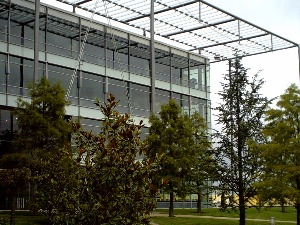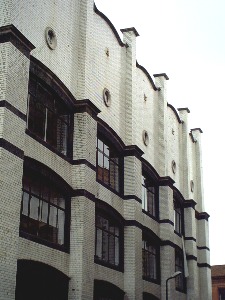
Additional Information
|
A Bedford Park & Chiswick
Park Walk Additional Information |
| london-footprints.co.uk |
BEDFORD PARK
In 1875 Jonathan T Carr, a cloth merchant, bought 24 acres of
land near Turnham Green Station with the intention of developing
an estate of Aesthetic houses in an informal setting. The first
houses were designed by E W Godwin but these were criticised and
he resigned to be replaced with Richard Norman Shaw. Shaw's
houses, in 'Queen Anne' style, featured red bricks & tiles,
tall chimneys, steep roofs & dormers, bay windows, balconies
and stained glass. Trees were retained and planted and gardens
had wooden fences. The general interior layout was a front
drawing room, back dining room and kitchen on the ground floor.
Above were 3 bedrooms, bath & WC with additional bedrooms on
the attic floor. There were no basements (the usual servant
domain) as sculleries, stores etc were in a single storey rear
extension. The houses were intended for the well-educated middle
classes of moderate means rather than 'carriage folk' so livery
stables were maintained by the stores. A few larger detached
houses were built including Carr's own home Tower House which had
16 rooms and a large garden with tennis and badminton courts.
Bedford Park was popular with artists & writers and
supporters of the Arts & Crafts movement, as championed by
John Ruskin and William Morris. Some residents even adopted an
Aesthetic style of dress.
Shaw resigned in the 1880s but remained as a consultant with E J
May appointed as the estate architect. After 1887 the land was
sold piecemeal and developed in various styles. The Bedford Park
Society was formed in 1963 to preserve the area after the
demolition of two houses, replaced with flats. However it only
finally got listing and conservation area status in the late 60's
having staged an exhibition in 1967.
Bedford Park set out to be a community by including a church,
pub, stores and School of Art (bombed in WWII). At the club
residents, including women, could socialise and events were
organised. It became a model for other suburban estates and
garden cities.
 |
CHISWICK
PARK This business park occupies a 33 acre site that was formerly a London Transport depot. Development by Stanhope began in the 1990s to a masterplan by Terry Farrell but was halted in the recession. The present project by Richards Rogers features buildings with concrete framing which can be customised by tenants. Extensive sunscreening has been devised and parking is included in the undercrofts. The buildings are set within a landscaped park with water features. In the same way that Bedford Park provided community amentities Chiswick Park has cafes and restaurants, sports facilities and an events programme. It even has the equivalent of livery stables as yellow bicycles are available for tenants use! [website] |
CHISWICK TOWN HALL
Prior to local councils the business of running the parish was
undertaken by the vestry, leading citizens who would meet in the
church or schoolroom. As the population rose and their
responsibilities increased there was a need for permanent office
space. A plot of land was purchased and a surveyor commissioned
to design offices and also a public hall which opened in 1876.
The Chiswick Urban District Council was formed in the 1890s and
extended the building at a cost of £20,000. The renamed Town
Hall, opened in 1901, included oak-panelled Council Chamber and
Committee Room. An additional smaller hall together with
cloakrooms and ticket booths enabled more functions to be held.
The extension was integrated with the old building and featured
lavish marble, stained glass, tiles and panelling. It continued
in use when in 1927-8 Chiswick was amalgamated with Brentford but
with the formation of the London Borough of Hounslow in 1965 much
of the local government was re-located. The building is now used
for a range of meetings and social events and has featured in TV
programmes such as 'Kavanagh QC' and 'The Bill'.
 |
THE
SANDERSON FACTORY (VOYSEY HOUSE) This Grade II* listed building was built as a wallpaper printing works for Sanderson & Sons in 1902 and is the only industrial building by CFA Voysey. The main factory, Devonshire Works, was opposite and a bridge at third floor level linked the two. Sandersons moved out after a fire in 1928 when the White Building (not damaged) was purchased by the Alliance Insurance Company. A major refurbishment was carried out by new owners in 1968. In 1984 it was occupied by architects Acanthus LW who stripped out later additions whilst adapting it for its own use. The building is a double square with four floors, the top one behind the parapet. The original windows had steel frames and the piers served as ventilation shafts. The eastern bay formed a service core. White glazed bricks are banded with Staffordshire blue bricks, now painted black. These have been restored with assistance from English Heritage following water damage. |
CHRIST CHURCH TURNHAM
GREEN
This was built and consecrated for worship in
1843. It was needed to accommodate the growing population
around Turnham Green who found the distance to St Nicholas (the
original parish church of Chiswick) too far and whose capacity
was becoming inadequate. An Act of Parliament was required for
permission to build it on the green. The appointment of a vicar
is in the gift of the Bishop London as the lands originally
belonged to St Paul's Cathedral. The building was one of the
first commissions of Sir Gilbert Scott and cost just under
£10,000. Originally there were galleries around three
sides as the seating in the nave pews was paid for by
subscription. The stained glass windows depict early English
saints and serve as memorial windows. Christ Church was used as
the garrision church when the army barracks were located in what
become the Army & Navy Repository. Chiswick is half way
between London and Windsor and the barracks housed the horses
when the guards moved between the two locations. In the early 20th
century the altar screen and choir stalls were carved by six
members of the congregation who attended lessons at the Arts
School in Bath Road. In the early 1990’s the pews were
removed and replaced with chairs. Later the original organ
was replaced with a digital one. The remaining galleries
were removed and a rear upper storey was created which provides a
large meeting room, two smaller rooms and a kitchen. The
church is generally open 12-2pm. [website]
Resources
The Bedford Park Society [website]
The Victorian Society have their headquarters at 1 Priory
Gardens, Bedford Park. [website]
St Michael & All Angels Church [wepage]
Pevsner - Buildings of England: London NW
© london-footprints.co.uk 2014
[route & what to see] [walks list]